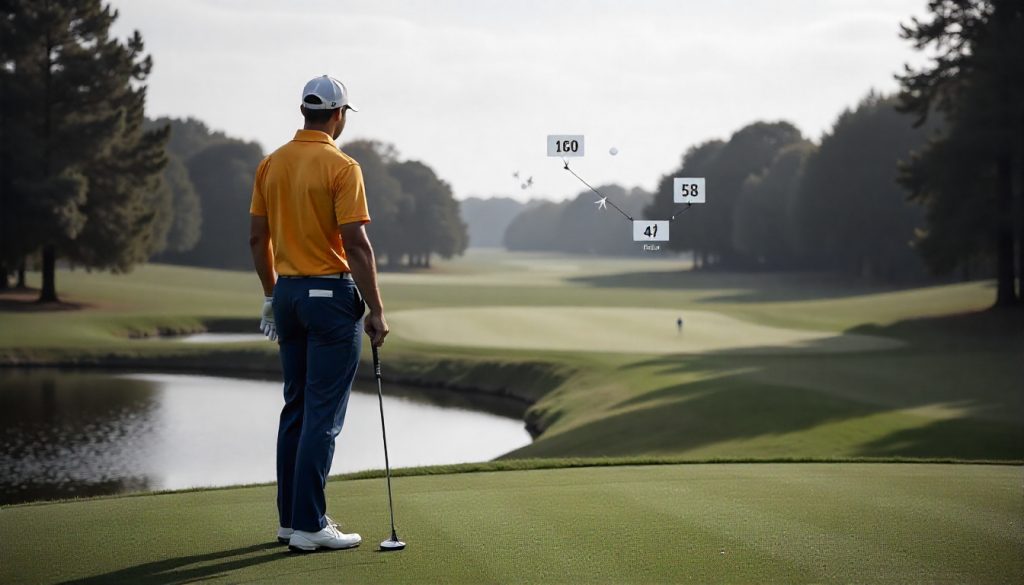
One Shot At Glory: Colin’s Bucket-List Strategy For The Brabazon at The Belfry
Hey golfers! Ever feel like your game has plateaued? You’re not alone. Many players find themselves in the mid-handicap range, consistently hitting decent shots but struggling to break through to the next level.
We created a comprehensive blueprint for a 40-year-old male golfer named Colin, who plays off a 15.9 handicap, to show him exactly how to approach his game like a pro. Colin is prepping for a bucket list round at the Brabazon course at the Belfry, host of 4 previous Ryder Cups, so he requested our help to get ready for it.
The Problem: Where Are His Strokes Going?
Colin’s data he sent us, particularly his Strokes Gained numbers, reveals the harsh truth: his biggest losses are coming from off the tee and on approach shots.
- Off the Tee: Colin is losing a significant -4.0 strokes, primarily due to a slight miss to the left. While his Fairways in Regulation (FIR) is a decent 76%, the shots he misses are costly. His driver distance of 210-230 yards is good, but his estimated swing speed of 91-100 mph suggests there’s room for optimization.
- Approach Shots: This is Colin’s biggest challenge, with a loss of -6.3 strokes. The Strokes Gained data indicates a lack of consistency and accuracy with his irons. This is likely tied to the same ball-striking issues that lead to his left misses off the tee.
- Around the Green: A loss of -3.0 strokes shows he’s not getting up and down as often as he could.
- Putting: A loss of -2.25 strokes per round isn’t terrible, but it’s a clear area for improvement. He averages 31 putts per round, which is fairly standard for his handicap, but reducing this is a sure way to save strokes.
The Solution: A Blueprint for Improvement
To fix these issues, Colin needs a holistic strategy that addresses his swing, his equipment, and his on-course decisions.
Swing & Ball-Striking Drills
- The Lane Drill: Place two alignment sticks or headcovers on the ground a few inches outside your clubhead at both the start and end of your swing arc. His goal is to swing the club between them, forcing a more consistent and centered strike.
- Stop-and-Go Drill: Take his club to the top of the backswing and pause for a beat. This forces a smoother transition, helping to eliminate a rushed, over-the-top move that can cause the ball to go left.
Pre- & Post-Round Routines
- Pre-Round Warm-Up: Arrive at the course at least 30 minutes before tee time. Start with dynamic stretches like arm circles and torso twists. Hit a few wedges, then move up to irons, a hybrid, and finally driver. Don’t worry about distance; focus on tempo and rhythm.
- Pre-Shot Routine: Before every shot, have a consistent routine. It can be as simple as standing behind the ball, picking a target, and taking two practice swings. His swing thought should be simple and actionable, like “turn and pull” to counter the left miss.
- Post-Round Stretches: After the round, take 5-10 minutes to stretch. Focus on his hamstrings, glutes, lower back, and shoulders. This improves flexibility and reduces soreness, helping him feel great for the next round.
Smart Equipment Choices
Golf Ball Recommendation

Since Colin’s biggest problem is a pull-hook, he needs a ball that helps manage spin. His moderate swing speed of around 95 mph means he can’t compress a super-firm, tour-level ball.
Our recommendations:
- Top Pick: TaylorMade Tour Response. This is a fantastic ball for Colin. It offers a soft feel and low-to-mid compression, which is perfect for his swing speed. Crucially, its urethane cover provides excellent short-game spin control without generating excessive driver spin, which will help straighten out his left miss.
- Winter Golf (Below 50°F): The Callaway Supersoft. This is a low-compression, two-piece ball designed for maximum distance in colder, denser air.
- Summer Golf (Above 90°F): The Titleist AVX. Its low-spin core will help control the ball flight in hotter, less dense air, and it’s a premium-performance ball that will feel great to Colin.
Check out How to Choose the Right Golf Ball for Your Game – The Ultimate Guide
Golf Club Recommendation

Colin needs clubs that prioritize forgiveness and consistency. This means a game-improvement or players-distance category.
We recommended:
- Driver: The Cobra Darkspeed Max with a Regular Flex (R) shaft weighing around 60 grams. Its low and back weighting provides maximum forgiveness, and the draw-bias setting can help counteract his left-to-right miss.
- Irons: A set like the Ping G430 Irons (5-PW) with Ping AWT 2.0 Regular Flex steel shafts. These are renowned for their forgiveness and high launch, which will help improve Colin’s approach shots.
Check out Ditch the Doubt: Unlock Your A-Game with Data-Driven Club Choices
A Walk Through History at The Brabazon
Before we dive into the strategy, let’s appreciate the stage. The Brabazon course at The Belfry is hallowed ground in the world of golf. Designed by Dave Thomas and Peter Alliss, it has hosted four Ryder Cups, more than any other course in the world. It was here that Seve Ballesteros, Nick Faldo, and other legends created some of the most iconic moments in golf history. The course’s signature features – tight fairways, strategic bunkering, and large, menacing lakes – have tested the world’s best.
Now, it’s Colin’s turn to take on this legendary course with a plan.

The Final Piece: Colin’s Strategy Around The Brabazon at The Belfry
Based on his driver distance, Colin’s ideal course length is around 5,880 to 6,440 yards (210 to 230 yards x 28). The Yellow tees at The Brabazon, at 6,449 yards, are the best fit for his game, offering a fair but challenging test.
His calculated Course Handicap from the Yellow tees is 21. This means he gets to take two strokes on the course’s hardest 3 holes (SI 1 – SI 3) and one stroke on the remaining 15 holes.
A crucial part of Colin’s overall strategy is avoiding penalties, especially on this water-laden course. With a tendency to miss left, holes 6, 8, 10, 17, and 18 will be particularly challenging. On these holes, he should aim for the safe side of the fairway and resist the temptation to “cut the corner” over water.
Colin’s Abbreviated Hole-by-Hole Strategy
- Hole 1 (Par 4, 369 yards): A gentle opener, but the bunkers are intimidating. With his left miss, Colin should aim for the right half of the fairway. This will give him a good angle into the slightly raised green.
- Hole 2 (Par 4, 321 yards): This is a short, tight par 4. Colin’s miss to the left is a real danger here with the right side lined with trees. He should take a hybrid or 5-wood off the tee, aiming slightly right of the left fairway bunker to set up a short approach.
- Hole 6 (Par 4, 385 yards): The lake down the entire left side makes this a formidable tee shot. Colin must aim well right of the fairway bunker, which is 200 yards out. He should play a 3-wood or a hybrid to ensure his ball stays on dry land. The long approach shot will require a solid long iron or hybrid.
- Hole 8 (Par 4, 409 yards): The number one handicap hole for a reason. Water is all the way down the left side. Colin needs to play for position and not distance. A 3-wood or even a hybrid off the tee, aimed squarely at the center of the fairway, will be the best strategy.
The Back 9
- Hole 10 (Par 4, 284 yards): The signature hole is a classic risk/reward. With a left miss and water, Colin should lay up with a hybrid or even a 5-iron to stay short of the water. This leaves a short pitch shot into the green, which should be his comfort zone.
- Hole 14 (Par 3, 166 yards): The green is shaped to favor a draw, but Colin’s natural left miss could turn into a hook and miss the green long and left. The smart play is to aim for the center of the green and let the natural shape of the shot carry the ball slightly left.
- Hole 15 (Par 5, 488 yards): This is a good birdie opportunity. The tee shot is blind, so a solid drive (with a slight fade if possible) is the best bet. He should lay up short of the bunkers at 60 yards from the green. This leaves a comfortable sand wedge shot, which he hits 75-90 yards.
- Hole 17 (Par 5, 530 yards): Another great birdie opportunity. The hole doglegs left to right, which can help Colin manage his left miss. He should aim a little right of the fairway, and his natural ball flight will bring it back to the center.
- Hole 18 (Par 4, 418 yards): The grand finale. The lake down the left side is intimidating. A smart play is to take a 3-wood or even a hybrid off the tee and aim well right of the water. This will leave a long approach over the water, which is a daunting task, so a short layup may be a good option.
The Final Score
This Elite Performance report for Colin offers a strategic framework to conquer a world-class course, focusing on high-percentage plays and risk mitigation. The path to a lower handicap is one of consistency, and by following this plan, Colin can work to reduce his handicap and unlock the next level of his game.
Colin’s Expected Score at the Belfry: His expected score, factoring in his course handicap, tendencies and penalties, is 93, calculated below.
- Par (72) + Course Handicap (21) + Penalties (0.3) = 93.3
- Expected score: ≈ 93 – 96
Take on Any Course With Confidence
Feeling ready to transform your game? This analysis is just the beginning. Our full Golf Course Intel strategy guide for The Brabazon at The Belfry (or any other course in the world) goes even deeper, providing a hole-by-hole, shot-by-shot blueprint tailored to a player just like you.
Click below to request your personalized Golf Course Intel strategy guide and start lowering your scores today!




0 Comments